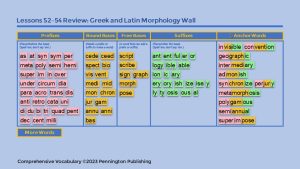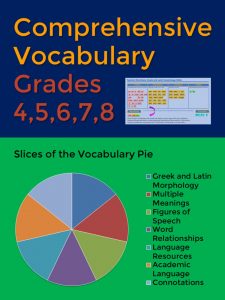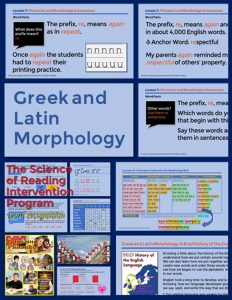
How to Memorize Greek and Latin Word Parts
In my related article, “Teach Morphemes, Not Academic Words,” I demonstrated why learning Greek and Latin morphemes (meaning-based word parts) is far more effective and efficient than learning whole words. However, the best way to learn the 60 highest frequency prefixes, roots, and suffixes is in the context of my 25 Greek and Latin Power Words. These 25 Power Words combine the 60 word parts into memorable associations.
To imprint these 60 word parts into our long-term memories, we need to take advantage of the way our brains are hard-wired. Our brains connect new input to previously learned input through a memory process we know as association.
You see, linking one thing to another can provide a memorable association. Once the association has been well-established, knowing one thing prompts the memory of the other.
That’s how we will learn the 60 Greek and Latin word parts‒through association. Each of the 25 Greek and Latin Power Words links two or three word parts to form a memorable association.
Let’s apply a few suggestions from memory research to help us create these associations.
4 Tips from Memory Research
- Learn it right the first time. The better a word part is originally learned and the better the two or three word parts are associated within the word, the more you will store in your long-term memory.
- People start forgetting immediately after learning, so make a conscious effort to rehearse the word parts and their definitions immediately after memorization. Information practiced immediately is retained. After the first few hours, the forgetting cycle kicks in.
- People remember smaller chunks of information that are rehearsed frequently. Short study periods with small amounts of learning each day produces better retention than cramming.
- People remember information best when that information is organized in a structured manner.
To memorize the 25 Greek and Latin Power Words in a structured manner, I’ve created a helpful FREE resource, titled the DUAL Word Parts Worksheet (at the end of this article), for you to download and print.
The DUAL Word Parts Worksheet

DUAL Word Parts Worksheet
The DUAL Word Parts Worksheet provides a structured approach to learning new vocabulary. Instead of rote memorization, which stores information only in the short-term memory, the worksheet will guide you with in-depth memorization, practice, and application to help you store this new vocabulary in your long-term memory. The DUAL Word Parts Worksheet serves a dual purpose: 1. To learn the 60 high frequency Greek and Latin word parts and 2. To associate these definitions with the 25 Greek and Latin Power Words in which they appear.
DUAL is an acronym, which stands for Define, Use, Apply, and Look.
I’ll teach you how to use the DUAL Word Parts Worksheet as we learn the first of our 25 Greek and Latin Power Words, unsubscribe. If you want the DUAL Word Parts Worksheet, it’s yours for FREE at the end of the article.
Our first step on the worksheet is the D, as in define. We need to define the word parts by memorizing each of their meanings.
Note that on your worksheet, the first column lists the Greek and Latin Power Word, unsubscribe; the second column lists the word parts, un, sub, and scrib(e); and the third column provides the word part definitions as not, under, and write.
By the way, both un and sub are prefixes and scrib(e) is a root. However, for our purposes we don’t need to identify which word parts are prefixes, roots, and suffixes, nor do we need to identify their parts of speech, nor do we need to know from which language each word part derives. Now, at this moment, classical scholars are all shaking their collective heads in dismay. But, as Winnie the Pooh might have said, “So much to remember rather muddles my thinking.”
Please note that the (e) at the end of scrib(e). The parentheses indicate a letter added to the word part to help with English pronunciation. In this case, the silent final e makes the preceding vowel a long /i/ sound. Sometimes a letter is dropped from a Greek and Latin word part to connect to another word part. Also, notice that there is no suffix in unsubscribe.
Take a moment to study the content in the first three columns: unsubscribe… un, sub, scribe… not, under, and write.
Now, let’s use the power of association to link the word parts together.
- Linking un and sub into “unsub” means not under in unsubscribe.”
- Linking sub and scribe into “subscribe means under write in unsubscribe.”
- Linking these paired word parts joins un, sub, and scribe into “unsubscribe,” which means not under write in unsubscribe.”
Now, that’s a memorable chain of word part associations! As our memory tip suggested, “We’ve learned it right the first time.”
Our second step on the DUAL Word Parts Worksheet is the U, as in use. We need to use the word parts and their definitions in memorable contexts.
Use each memorized word part in a simple, memorable, and concrete anchor word, and write this word in the fourth column of your worksheet. A good anchor word for the un word part is untie. It’s simple, memorable, and concrete, not abstract. For un, write the anchor word, untie, in the space provided.
Next, use that anchor word in a brief context clue sentence with surrounding word clues which show the meaning of that anchor word. Use my SALE Context Clues acronym (S for synonym, A for antonym, L for logic, or E for example) to prompt your use of surrounding word clues.
Write the following context clue sentence for the first anchor word, untie, in the fifth column: “I had to untie my shoelaces to slip off my shoes.”
Now provide your own anchor words and context clue sentences for sub and scribe in the fourth and fifth columns.

Comprehensive Vocabulary
Our third step on the DUAL Word Parts Worksheet is the A, as in associate. We need to associate our anchor words to Related Words we already know, which feature our focus word parts.
For my untie anchor word, I might write these Related Words: unworthy and unmarried in the sixth column.
Now write a few Related Words you already known for your sub and scribe anchor words in that sixth column.
Our fourth and last step on the DUAL Word Parts Worksheet is the L, as in look. We need to look for the newly learned word parts in everything we hear and in everything we read. Also, look for ways to use these word parts in your speech and writing. Remember our memory tip: “People remember smaller chunks of information that are rehearsed frequently.”
Dr. Kevin Flanigan, contributing author to Vocabulary Their Way calls this look step, “Turning on your morphological radar.” Dr. Flanigan suggests that the more we look at challenging words, by their structural components, rather than as whole words, the more attuned we will become to identifying the morphemes, which are the meaning-based word parts we are learning.
So, turn on your “morphological radar” and start looking for the word parts: un, sub, and scribe in everything you listen to and read.
Whew! It’s time to pat yourself on the back. You’ve just placed the three word parts: un, sub, and scribe into your long-term memory. You won’t forget these short-cuts which unlock the meanings of challenging words. And what’s more… these three word parts are found in 5,083 words. That’s 5,083 words. Awesome!
Plus, you’ve learned how to use the four steps of the the DUAL Word Parts Worksheet to memorize, practice, and apply the rest of the 25 Greek and Latin Power Words. I suggest you tackle one per day. Teachers may wish to tackle one or two per week with their students. Remember our memory tip: “Short study periods with small amounts of learning each day produces better retention than cramming.” And keep rehearsing the old word parts as you learn the new ones.
*****
For full-year vocabulary programs which include multiple meaning words (L.4.a.), Greek and Latin morphology with Morphology Walls (L.4.a.), figures of speech (L.5.a.), words with special relationships (L.5.b.), words with connotative meanings (L.5.c.), and academic language words (L.6.0), check out the assessment-based grades 4, 5, 6, 7, and 8 Comprehensive Vocabulary.
Get the Grades 4,5,6,7,8 Vocabulary Sequence of Instruction FREE Resource:

Get the Greek and Latin Morphology Walls FREE Resource:

Get the Diagnostic Academic Language Assessment FREE Resource:

Get the DUAL Word Parts Worksheet FREE Resource:

Literacy Centers, Reading, Spelling/Vocabulary, Study Skills
25 Greek and Latin Power Words, Common Core Vocabulary, Common Core Vocabulary Toolkit, DUAL Word Parts Worksheet, Greek and Latin, Greek and Latin Morphology, Greek and Latin prefixes, Greek and Latin roots, Greek and Latin suffixes, Greek and Latin vocabulary, Greek and Latin word lists, high frequency word parts, Mark Pennington, memorize vocabulary, morphological, morphological awareness, morphology walls, research-based vocabulary word lists






